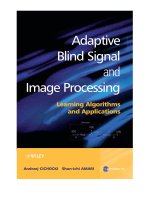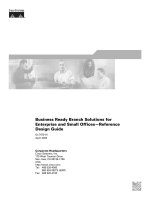mohamed najim - digital filters design for signal and image processing
Bạn đang xem bản rút gọn của tài liệu. Xem và tải ngay bản đầy đủ của tài liệu tại đây (4.99 MB, 386 trang )
Digital Filters Design for Signal and Image Processing
This page intentionally left blank
Digital Filters Design for
Signal and Image Processing
Edited by
Mohamed Najim
First published in France in 2004 by Hermès Science/Lavoisier entitled “Synthèse de filtres
numériques en traitement du signal et des images”
First published in Great Britain and the United States in 2006 by ISTE Ltd
Apart from any fair dealing for the purposes of research or private study, or criticism or
review, as permitted under the Copyright, Designs and Patents Act 1988, this publication may
only be reproduced, stored or transmitted, in any form or by any means, with the prior
permission in writing of the publishers, or in the case of reprographic reproduction in
accordance with the terms and licenses issued by the CLA. Enquiries concerning reproduction
outside these terms should be sent to the publishers at the undermentioned address:
ISTE Ltd ISTE USA
6 Fitzroy Square
4308 Patrice Road
London W1T 5DX
Newport Beach, CA 92663
UK USA
www.iste.co.uk
© ISTE Ltd, 2006
© LAVOISIER, 2004
The rights of Mohamed Najim to be identified as the author of this work have been asserted
by him in accordance with the Copyright, Designs and Patents Act 1988.
___________________________________________________________________________
Library of Congress Cataloging-in-Publication Data
Synthèse de filtres numériques en traitement du signal et des images.
English
Digital filters design for signal and image processing/edited by Mohamed Najim.
p. cm.
Includes index.
ISBN-13: 978-1-905209-45-3
ISBN-10: 1-905209-45-2
1. Electric filters, Digital. 2. Signal processing Digital techniques.
3. Image processing Digital techniques. I. Najim, Mohamed. II. Title.
TK7872.F5S915 2006
621.382'2 dc22
2006021429
British Library Cataloguing-in-Publication Data
A CIP record for this book is available from the British Library
ISBN 10: 1-905209-45-2
ISBN 13: 978-1-905209-45-3
Printed and bound in Great Britain by Antony Rowe Ltd, Chippenham, Wiltshire.
Table of Contents
Introduction xiii
Chapter 1. Introduction to Signals and Systems 1
Yannick BERTHOUMIEU, Eric GRIVEL and Mohamed NAJIM
1.1. Introduction 1
1.2. Signals: categories, representations and characterizations 1
1.2.1. Definition of continuous-time and discrete-time signals 1
1.2.2. Deterministic and random signals 6
1.2.3. Periodic signals 8
1.2.4. Mean, energy and power 9
1.2.5. Autocorrelation function 12
1.3. Systems 15
1.4. Properties of discrete-time systems 16
1.4.1. Invariant linear systems 16
1.4.2. Impulse responses and convolution products 16
1.4.3. Causality 17
1.4.4. Interconnections of discrete-time systems 18
1.5. Bibliography 19
Chapter 2. Discrete System Analysis 21
Mohamed NAJIM and Eric GRIVEL
2.1. Introduction 21
2.2. The z-transform 21
2.2.1. Representations and summaries 21
2.2.2. Properties of the z-transform 28
2.2.2.1. Linearity 28
2.2.2.2. Advanced and delayed operators 29
2.2.2.3. Convolution 30
vi Digital Filters Design for Signal and Image Processing
2.2.2.4. Changing the z-scale 31
2.2.2.5. Contrasted signal development 31
2.2.2.6. Derivation of the z-transform 31
2.2.2.7. The sum theorem 32
2.2.2.8. The final-value theorem 32
2.2.2.9. Complex conjugation 32
2.2.2.10. Parseval’s theorem 33
2.2.3. Table of standard transform 33
2.3. The inverse z-transform 34
2.3.1. Introduction 34
2.3.2. Methods of determining inverse z-transforms 35
2.3.2.1. Cauchy’s theorem: a case of complex variables 35
2.3.2.2. Development in rational fractions 37
2.3.2.3. Development by algebraic division of polynomials 38
2.4. Transfer functions and difference equations 39
2.4.1. The transfer function of a continuous system 39
2.4.2. Transfer functions of discrete systems 41
2.5. Z-transforms of the autocorrelation and intercorrelation functions . . . 44
2.6. Stability 45
2.6.1. Bounded input, bounded output (BIBO) stability 46
2.6.2. Regions of convergence 46
2.6.2.1. Routh’s criterion 48
2.6.2.2. Jury’s criterion 49
Chapter 3. Frequential Characterization of Signals and Filters 51
Eric GRIVEL and Yannick BERTHOUMIEU
3.1. Introduction 51
3.2. The Fourier transform of continuous signals 51
3.2.1. Summary of the Fourier series decomposition of continuous
signals 51
3.2.1.1. Decomposition of finite energy signals using an orthonormal
base 51
3.2.1.2. Fourier series development of periodic signals 52
3.2.2. Fourier transforms and continuous signals 57
3.2.2.1. Representations 57
3.2.2.2. Properties 58
3.2.2.3. The duality theorem 59
3.2.2.4. The quick method of calculating the Fourier transform 59
3.2.2.5. The Wiener-Khintchine theorem 63
3.2.2.6. The Fourier transform of a Dirac comb 63
3.2.2.7. Another method of calculating the Fourier series development
of a periodic signal 66
Table of Contents vii
3.2.2.8. The Fourier series development and the Fourier transform . . . 68
3.2.2.9. Applying the Fourier transform: Shannon’s sampling theorem . 75
3.3. The discrete Fourier transform (DFT) 78
3.3.1. Expressing the Fourier transform of a discrete sequence 78
3.3.2. Relations between the Laplace and Fourier z-transforms 80
3.3.3. The inverse Fourier transform 81
3.3.4. The discrete Fourier transform 82
3.4. The fast Fourier transform (FFT) 86
3.5. The fast Fourier transform for a time/frequency/energy representation
of a non-stationary signal 90
3.6. Frequential characterization of a continuous-time system 91
3.6.1. First and second order filters 91
3.6.1.1. 1
st
order system 91
3.6.1.2. 2
nd
order system 93
3.7. Frequential characterization of discrete-time system 95
3.7.1. Amplitude and phase frequential diagrams 95
3.7.2. Application 96
Chapter 4. Continuous-Time and Analog Filters 99
Daniel BASTARD and Eric GRIVEL
4.1. Introduction 99
4.2. Different types of filters and filter specifications 99
4.3. Butterworth filters and the maximally flat approximation 104
4.3.1. Maximally flat functions (MFM) 104
4.3.2. A specific example of MFM functions: Butterworth polynomial
filters 106
4.3.2.1. Amplitude-squared expression 106
4.3.2.2. Localization of poles 107
4.3.2.3. Determining the cut-off frequency at –3 dB and filter orders . . 110
4.3.2.4. Application 111
4.3.2.5. Realization of a Butterworth filter 112
4.4. Equiripple filters and the Chebyshev approximation 113
4.4.1. Characteristics of the Chebyshev approximation 113
4.4.2. Type I Chebyshev filters 114
4.4.2.1. The Chebyshev polynomial 114
4.4.2.2. Type I Chebyshev filters 115
4.4.2.3. Pole determination 116
4.4.2.4. Determining the cut-off frequency at –3 dB and the filter order 118
4.4.2.5. Application 121
4.4.2.6. Realization of a Chebyshev filter 121
4.4.2.7. Asymptotic behavior 122
4.4.3. Type II Chebyshev filter 123
viii Digital Filters Design for Signal and Image Processing
4.4.3.1. Determining the filter order and the cut-off frequency 123
4.4.3.2. Application 124
4.5. Elliptic filters: the Cauer approximation 125
4.6. Summary of four types of low-pass filter: Butterworth, Chebyshev
type I, Chebyshev type II and Cauer 125
4.7. Linear phase filters (maximally flat delay or MFD): Bessel and
Thomson filters 126
4.7.1. Reminders on continuous linear phase filters 126
4.7.2. Properties of Bessel-Thomson filters 128
4.7.3. Bessel and Bessel-Thomson filters 130
4.8. Papoulis filters (optimum (O
n
)) 132
4.8.1. General characteristics 132
4.8.2. Determining the poles of the transfer function 135
4.9. Bibliography 135
Chapter 5. Finite Impulse Response Filters 137
Yannick BERTHOUMIEU, Eric GRIVEL and Mohamed NAJIM
5.1. Introduction to finite impulse response filters 137
5.1.1. Difference equations and FIR filters 137
5.1.2. Linear phase FIR filters 142
5.1.2.1. Representation 142
5.1.2.2. Different forms of FIR linear phase filters 147
5.1.2.3. Position of zeros in FIR filters 150
5.1.3. Summary of the properties of FIR filters 152
5.2. Synthesizing FIR filters using frequential specifications 152
5.2.1. Windows 152
5.2.2. Synthesizing FIR filters using the windowing method 159
5.2.2.1. Low-pass filters 159
5.2.2.2. High-pass filters 164
5.3. Optimal approach of equal ripple in the stop-band and passband 165
5.4. Bibliography 172
Chapter 6. Infinite Impulse Response Filters 173
Eric GRIVEL and Mohamed NAJIM
6.1. Introduction to infinite impulse response filters 173
6.1.1. Examples of IIR filters 174
6.1.2. Zero-loss and all-pass filters 178
6.1.3. Minimum-phase filters 180
6.1.3.1. Problem 180
6.1.3.2. Stabilizing inverse filters 181
6.2. Synthesizing IIR filters 183
6.2.1. Impulse invariance method for analog to digital filter conversion . 183
Table of Contents ix
6.2.2. The invariance method of the indicial response 185
6.2.3. Bilinear transformations 185
6.2.4. Frequency transformations for filter synthesis using low-pass
filters 188
6.3. Bibliography 189
Chapter 7. Structures of FIR and IIR Filters 191
Mohamed NAJIM and Eric GRIVEL
7.1. Introduction 191
7.2. Structure of FIR filters 192
7.3. Structure of IIR filters 192
7.3.1. Direct structures 192
7.32. The cascade structure 209
7.3.3. Parallel structures 211
7.4. Realizing finite precision filters 211
7.4.1. Introduction 211
7.4.2. Examples of FIR filters 212
7.4.3. IIR filters 213
7.4.3.1. Introduction 213
7.4.3.2. The influence of quantification on filter stability 221
7.4.3.3. Introduction to scale factors 224
7.4.3.4. Decomposing the transfer function into first- and
second-order cells 226
7.5. Bibliography 231
Chapter 8. Two-Dimensional Linear Filtering 233
Philippe BOLON
8.1. Introduction 233
8.2. Continuous models 233
8.2.1. Representation of 2-D signals 233
8.2.2. Analog filtering 235
8.3. Discrete models 236
8.3.1. 2-D sampling 236
8.3.2. The aliasing phenomenon and Shannon’s theorem 240
8.3.2.1. Reconstruction by linear filtering (Shannon’s theorem) 240
8.3.2.2. Aliasing effect 240
8.4. Filtering in the spatial domain 242
8.4.1. 2-D discrete convolution 242
8.4.2. Separable filters 244
8.4.3. Separable recursive filtering 246
8.4.4. Processing of side effects 249
8.4.4.1. Prolonging the image by pixels of null intensity 250
x Digital Filters Design for Signal and Image Processing
8.4.4.2. Prolonging by duplicating the border pixels 251
8.4.4.3. Other approaches 252
8.5. Filtering in the frequency domain 253
8.5.1. 2-D discrete Fourier transform (DFT) 253
8.5.2. The circular convolution effect 255
8.6. Bibliography 259
Chapter 9. Two-Dimensional Finite Impulse Response Filter Design 261
Yannick BERTHOUMIEU
9.1. Introduction 261
9.2. Introduction to 2-D FIR filters 262
9.3. Synthesizing with the two-dimensional windowing method 263
9.3.1. Principles of method 263
9.3.2. Theoretical 2-D frequency shape 264
9.3.2.1. Rectangular frequency shape 264
9.3.2.2. Circular shape 266
9.3.3. Digital 2-D filter design by windowing 271
9.3.4. Applying filters based on rectangular and circular shapes 271
9.3.5. 2-D Gaussian filters 274
9.3.6. 1-D and 2-D representations in a continuous space 274
9.3.6.1. 2-D specifications 276
9.3.7. Approximation for FIR filters 277
9.3.7.1. Truncation of the Gaussian profile 277
9.3.7.2. Rectangular windows and convolution 279
9.3.8. An example based on exploiting a modulated Gaussian filter 280
9.4. Appendix: spatial window functions and their implementation 286
9.5. Bibliography 291
Chapter 10. Filter Stability 293
Michel BARRET
10.1. Introduction 293
10.2. The Schur-Cohn criterion 298
10.3. Appendix: resultant of two polynomials 314
10.4. Bibliography 319
Chapter 11. The Two-Dimensional Domain 321
Michel BARRET
11.1. Recursive filters 321
11.1.1. Transfer functions 321
11.1.2. The 2-D z-transform 322
11.1.3. Stability, causality and semi-causality 324
Table of Contents xi
11.2. Stability criteria 328
11.2.1. Causal filters 329
11.2.2. Semi-causal filters 332
11.3. Algorithms used in stability tests 334
11.3.1. The jury Table 334
11.3.2. Algorithms based on calculating the Bezout resultant 339
11.3.2.1. First algorithm 340
11.3.2.2. Second algorithm 343
11.3.3. Algorithms and rounding-off errors 347
11.4. Linear predictive coding 351
11.5. Appendix A: demonstration of the Schur-Cohn criterion 355
11.6. Appendix B: optimum 2-D stability criteria 358
11.7. Bibliography 362
List of Authors 365
Index 367
This page intentionally left blank
Introduction
Over the last decade, digital signal processing has matured; thus, digital signal
processing techniques have played a key role in the expansion of electronic products
for everyday use, especially in the field of audio, image and video processing.
Nowadays, digital signal is used in MP3 and DVD players, digital cameras, mobile
phones, and also in radar processing, biomedical applications, seismic data
processing, etc.
This book aims to be a text book which presents a thorough introduction to
digital signal processing featuring the design of digital filters. The purpose of the
first part (Chapters 1 to 9) is to initiate the newcomer to digital signal and image
processing whereas the second part (Chapters 10 and 11) covers some advanced
topics on stability for 2-D filter design. These chapters are written at a level that is
suitable for students or for individual study by practicing engineers.
When talking about filtering methods, we refer to techniques to design and
synthesize filters with constant filter coefficients. By way of contrast, when dealing
with adaptive filters, the filter taps change with time to adjust to the underlying
system. These types of filters will not be addressed here, but are presented in various
books such as [HAY 96], [SAY 03], [NAJ 06].
Chapter 1 provides an overview of various classes of signals and systems. It
discusses the time-domain representations and characterizations of the continuous-
time and discrete-time signals.
Chapter 2 details the background for the analysis of discrete-time signals. It
mainly deals with the z-transform, its properties and its use for the analysis of linear
systems, represented by difference equations.
xiv Digital Filters Design for Signal and Image Processing
Chapter 3 is dedicated to the analysis of the frequency properties of signals and
systems. The Fourier transform, the discrete Fourier transform (DFT) and the fast
Fourier transform (FFT) are introduced along with their properties. In addition, the
well-known Shannon sampling theorem is recalled.
As we will see, some of the most popular techniques for digital infinite impulse
response (IIR) filter design benefit from results initially developed for analog
signals. In order to make the reader’s task easy, Chapter 4 is devoted to continuous-
time filter design. More particularly, we recall several approximation techniques
developed by mathematicians such as Chebyshev or Legendre, who have thus seen
their names associated with techniques of filter design.
The following chapters form the core of the book. Chapter 5 deals with the
techniques to synthesize finite impulse response (FIR) filters. Unlike IIR filters,
these have no equivalent in the continuous-time domain. The so-called windowing
method, as a FIR filter design method, is first presented. This also enables us to
emphasize the key role played by the windowing in digital signal processing, e.g.,
for frequency analysis. The Remez algorithm is then detailed.
Chapter 6 concerns IIR filters. The most popular techniques for analog to digital
filter conversion, such as the bilinear transform and the impulse invariance method,
are presented. As the frequency response of these filters is represented by rational
functions, we must tackle the problems of stability induced by the existence of poles
of these rational functions.
In Chapter 7, we address the selection of the filter structure and point out its
importance for filter implementation. Some problems due to the finite-precision
implementation are listed and we provide rules to choose an appropriate structure
while implementing filter on fixed point operating devices.
In comparison with many available books dedicated to digital filtering, this title
features both 1-D and 2-D systems, and as such covers both signal and image
processing. Thus, in Chapters 8 and 9, 2-D filtering is investigated.
Moreover, it is not easy to establish the necessary and sufficient conditions to
test the stability of 2-D signals. Therefore, Chapters 10 and 11 are dedicated to the
difficult problem of the stability of 2-D digital system, a topic which is still the
subject of many works such as [ALA 2003] [SER 06]. Even if these two chapters are
not a prerequisite for filter design, they can provide the reader who would like to
study the problems of stability in the multi-dimensional case with valuable
clarifications. This contribution is another element that makes this book stand out.
Introduction xv
The field of digital filtering is often perceived by students as a “patchwork” of
formulae and recipes. Indeed, the methods and concepts are based on several
specific optimization techniques and mathematical results which are difficult to
grasp.
For instance, we have to remember that the so-called Parks-McClellan algorithm
proposed in 1972 was first rejected by the reviewers [PAR 72]. This was probably
due to the fact that the size of the submitted paper, i.e., 5 pages, did not enable the
reviewers to understand every step of the approach [McC 05].
In this book we have tried, at every stage, to justify the necessity of these
approaches without recalling all the steps of the derivation of the algorithm. They
are described in many articles published during the 1970s in the IEEE periodicals
i.e., Transactions on Acoustics Speech and Signal Processing, which has since
become Transactions on Signal Processing and Transactions on Circuits and
Systems.
Mohamed NAJIM
Bordeaux
[ALA 2003] ALATA O., NAJIM M., RAMANANJARASOA C. and TURCU F., “Extension
of the Schur-Cohn Stability Test for 2-D AR Quarter-Plane Model”, IEEE Trans. on
Information Theory, vol. 49, no. 11, November 2003.
[HAY 96] HAYKIN S., Adaptive Filter Theory, 3
rd
edition, Prentice Hall, 1996.
[McC 05] McCLELLAN J.H. and PARKS W. Th., “A Personal History of the Parks-
McClellan Algorithm” IEEE Signal Processing Magazine, pp 82-86, March 2005.
[NAJ 06] NAJIM M., Modélisation, estimation et filtrage optimale en traitement du signal,
forthcoming, 2006, Hermes, Paris.
[PAR 72] PARKS W. Th. and McCLELLAN J.H., “Chebyshev Approximation for
Nonrecursive Digital Filters with Linear Phase,” IEEE Trans. Circuit Theory, vol. CT-19,
no. 2, pp 189-194, 1972.
[SAY 03] SAYED A., Fundamentals of Adaptive Filtering, Wiley IEEE Press, 2003.
[SER 06] SERBAN I., TURCU F., NAJIM M., “Schur Coefficients in Several Variables”,
Journal of Mathematical Analysis and Applications, vol. 320, issue no. 1, August 2006,
pp 293-302.
This page intentionally left blank
Chapter 1
Introduction to Signals and Systems
1.1. Introduction
Throughout a range of fields as varied as multimedia, telecommunications,
geophysics, astrophysics, acoustics and biomedicine, signals and systems play a
major role. Their frequential and temporal characteristics are used to extract and
analyze the information they contain. However, what importance do signals and
systems really hold for these disciplines? In this chapter we will look at some of the
answers to this question.
First we will discuss different types of continuous and discrete-time signals,
which can be termed random or deterministic according to their nature. We will also
introduce several mathematical tools to help characterize these signals. In addition,
we will describe the acquisition chain and processing of signals.
Later we will define the concept of a system, emphasizing invariant discrete-time
linear systems.
1.2. Signals: categories, representations and characterizations
1.2.1. Definition of continuous-time and discrete-time signals
The function of a signal is to serve as a medium for information. It is a
representation of the variations of a physical variable.
Chapter written by Yannick BERTHOUMIEU, Eric GRIVEL and Mohamed NAJIM.
2 Digital Filters Design for Signal and Image Processing
A signal can be measured by a sensor, then analyzed to describe a physical
phenomenon. This is the situation of a tension taken to the limits of a resistance in
order to verify the correct functioning of an electronic board, as well as, to cite one
example, speech signals that describe air pressure fluctuations perceived by the
human ear.
Generally, a signal is a function of time. There are two kinds of signals:
continuous and discrete-time.
A continuous-time or analog signal can be measured at certain instants. This
means physical phenomena create, for the most part, continuous-time signals.
Figure 1.1. Example of the sleep spindles of
an electroencephalogram (EEG) signal
The advancement of computer-based techniques at the end of the 20
th
century led
to the development of digital methods for information processing. The capacity to
change analog signals to digital signals has meant a continual improvement in
processing devices in many application fields. The most significant example of this
is in the field of telecommunications, especially in cell phones and digital
televisions. The digital representation of signals has led to an explosion of new
techniques in other fields as varied as speech processing, audiofrequency signal
analysis, biomedical disciplines, seismic measurements, multimedia, radar and
measurement instrumentation, among others.
Time (s)
Introduction to Signals and Systems 3
The signal is said to be a discrete-time signal when it can be measured at certain
instants; it corresponds to a sequence of numerical values. Sampled signals are the
result of sampling, uniform or not, of a continuous-time signal. In this work, we are
especially interested in signals taken at regular intervals of time, called sampling
periods, which we write as
1
=
s
s
T
f
where f
s
is called the sampling rate or the
sampling frequency. This is the situation for a temperature taken during an
experiment, or of a speech signal (see Figure 1.2). This discrete signal can be written
either as x(k) or x(kT
s
). Generally, we will use the first writing for its simplicity. In
addition, a digital signal is a discrete-time discrete-valued signal. In that case, each
signal sample value belongs to a finite set of possible values.
0.1
0.2
0.3
0.4
0.5
0.6
0.7
0.8
0.9
1
-1.5
-1
-0.5
0
0.5
1
1.5
2
2.5
x 10
4
Figure 1.2. Example of a digital voiced speech signal
(the sampling frequency f
s
is at 16 KHz)
The choice of a sampling frequency depends on the applications being used and
the frequency range of the signal to be sampled. Table 1.1 gives several examples of
sampling frequencies, according to different applications.
Time (s)
4 Digital Filters Design for Signal and Image Processing
Signal
f
s
T
s
Speech:
Telephone band – telephone-
Broadband – audio-visual conferencing-
8 KHz
or 16 KHz
125 µs
62.5 µs
Audio: Broadband (Stereo)
32 KHz
44.1 KHz
48 KHz
31.25 µs
22.7 µs
20.8 µs
Video 10 MHz 100 ns
Table 1.1. Sampling frequencies according to processed signals
In Figure 1.3, we show an acquisition chain, a processing chain and a signal
restitution chain.
The adaptation amplifier makes the input signal compatible with the
measurement chain.
A pre-filter which is either pass-band or low-pass, is chosen to limit the width of
the input signal spectrum; this avoids the undesirable spectral overlap and hence, the
loss of spectral information (aliasing). We will return to this point when we discuss
the sampling theorem in section 3.2.2.9. This kind of anti-aliasing filter also makes
it possible to reject the out-of-band noise and, when it is a pass-band filter, it helps
suppress the continuous component of the signal.
The Analog-to-Digital Converter (A/D) partly carries out sampling, and then
quantification, at the sampling frequency f
s
, that is, it allocates a coding to each
sampling on a certain number of bits.
The digital input signal is then processed in order to give the digital output
signal. The reconversion into an analog signal is made possible by using a D/A
converter and a smoothing filter.
Many parameters influence sampling, notably the quantification step and the
response time of the digital system, both during acquisition and restitution.
However, by improving the precision of the A/D converter and the speed of the
calculators, we can get around these problems. The choice of the sampling
frequency also plays an important role.
Introduction to Signals and Systems 5
Figure 1.3. Complete acquisition chain and digital processing of a signal
Different types of digital signal representation are possible, such as functional
representations, tabulated representations, sequential representations, and graphic
representations (as in bar diagrams).
Looking at examples of basic digital signals, we return to the unit sample
sequence represented by the Kronecker symbol δ(k), the unit step signal u(k), and
the unit ramp signal r(k). This gives us:
Unit sample sequence:
()
()
01
1for 0kk
δ
δ
=
⎧
⎪
⎨
=≠
⎪
⎩
Physical
variable
Digital
input
signal
Processing
A/D converter
Low-pass filter
or pass-band
Adaptation
amplifier
Sampling
blocker
Smoothing
filter
Processed
signal
D/A
converter
Digital
output
signal
Digital system
Analog
si
g
nal
Sensor
6 Digital Filters Design for Signal and Image Processing
Unit step signal:
()
()
1for 0
0for 0
uk k
uk k
⎧ =≥
⎪
⎨
=<
⎪
⎩
Unit ramp signal:
()
()
for 0
0for 0.
rk k k
rk k
⎧ =≥
⎪
⎨
=<
⎪
⎩
-10 -8
-6
-4 -2 0 2 4 6 8 10
0
0.2
0.4
0.6
0.8
1
Scale
amplitude
impulse unity
-10 -8
-6
-4 -2 0 2 4 6 8 10
0
0.2
0.4
0.6
0.8
1
indices
amplitude
unity
Figure 1.4. Unit sample sequence δ(k) and unit step signal u(k)
1.2.2. Deterministic and random signals
We class signals as being deterministic or random. Random signals can be
defined according to the domain in which they are observed. Sometimes, having
specified all the experimental conditions of obtaining the physical variable, we see
that it fluctuates. Its values are not completely determined, but they can be evaluated
in terms of probability. In this case, we are dealing with a random experiment and
the signal is called random. In the opposite situation, the signal is called
deterministic.
Introduction to Signals and Systems 7
Figure 1.5. Several realizations of a 1-D random signal
EXAMPLE 1.1.– let us look at a continuous signal modeled by a sinusoidal function
of the following type.
() ( )
sin 2π
x
ta ft=×
This kind of model is deterministic. However, in other situations, the signal
amplitude and the signal frequency can be subject to variations. Moreover, the signal
can be disturbed by an additive noise b(t); then it is written in the following form:
() () ()
()
()
sin 2π
x
tat fttbt=× ×+
where a(t), f(t) and b(t) are random variables for each value of t. We say then that
x(t) is a random signal. The properties of the received signal x(t) then depends on the
statistical properties of these random variables.
samples
realization no.5 realization no.4 realization no.3 realization no.2 realization no.1
8 Digital Filters Design for Signal and Image Processing
Figure 1.6. Several examples of a discrete random 2-D process
1.2.3. Periodic signals
The class of signals termed periodic plays an important role in signal and image
processing. In the case of a continuous-time signal, a signal is called periodic of
period T
0
if T
0
is the smallest value verifying the relation:
()()
txTtx =+
0
, t∀ .
And, for a discrete-time signal, the period of which is N
0
, we have:
()()
kxNkx =+
0
, k∀ .
EXAMPLE 1.2.– examples of periodic signals:
() ( )
0
sin 2π
x
tft=
,
() ( )
k
kx 1−= ,
()
⎟
⎠
⎞
⎜
⎝
⎛
=
8
cos
π
k
kx
.









